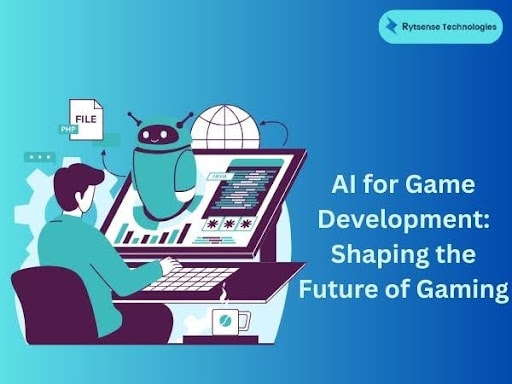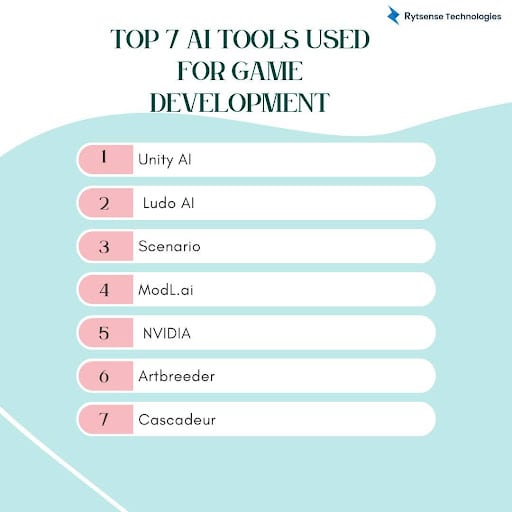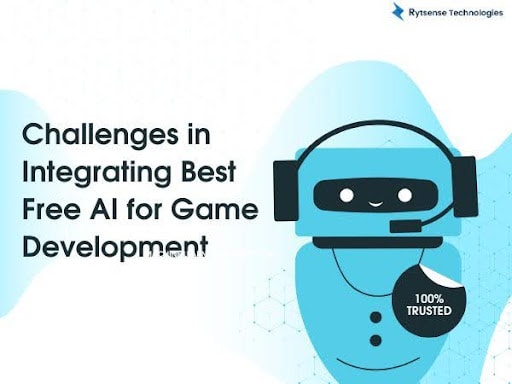-
Key Takeaways
- The AI game development market will be reaching $21.26 billion by 2034 showing explosive growth.
- It enables small indie teams in creating experiences and assets which needs large specialized teams and proper budgets
- Comprehensive AI tools integrate across the entire AI development cycle that accelerates timelines while quality enhancement.
- AI tools foster creative experimentation and bring innovative concepts to market faster than before.
- AI shows dynamic and adaptive gameplay through intelligent NPCs and real-time content generation that responds to individual player behaviour.
AI for Game Development: Shaping the Future of Gaming

The Global AI Game Generator Market is expected to reach USD 21.26 billion in 2034 from USD 1.64 billion in 2024, growing at a compound annual growth rate of 29.2%. Modern AI developers employ complex AI technologies to accelerate the design cycle while simultaneously elevating quality. If generating photorealistic environments, planning non-player behaviour, or fine-tuning player skill curves, artificial intelligence equips large publishers and independent teams alike to produce experiences that previously resided in the realm of speculation.
A momentous shift now occurs within the gaming sector, led by an advancing class of artificial intelligence tools that deeply redefine the processes of design, interactivity, and enduring player engagement. Leveraging the computational powers of neural networks and machine learning, the application domain of best AI for game development has emerged as an ancient impulse for constructing increasingly immersive, effective, and player-centric entertainment that commands the global player base.
Progress in generative AI for games centers on the seamless orchestration of machine and human mind. Developers of all skill levels, including novices on introductory projects and seasoned disciplines aiming for optimization find value-pitched interfaces and purpose tuned algorithms that decipher and accelerate inherent design intent. Continuous refinement of AI conversational agents, parameter-tuning dashboards, and model-embedding workflows serves both to democratize and to deepen the craft of interactive storytelling.
A strategic, diverse application of available AI genres produces superior outcomes. Automated sculpting of 3D environments, narrative branching stitchers, and play-balancing simulators function interchangeably and recursively to generate, polish, and validate content. Selecting the appropriate technology chain, whether differentiable modular synthesis, reinforcement evaluators, or predictive inverse kinematics, hinges on the unique mechanical, aesthetic, and financial decisions of each project. Mastery of pipelines is accelerated by disciplined testing and retraining, never by rote.
Why is AI for Game Development Vital?
The integration or merger of AI in game development is not optional; it is a foundational technology that notices a group of challenges uniquely characteristic of large-scale interactive entertainment projects. Today’s titles feature ever-expanding worlds, sophisticated narratives, and expansive team compositions, hallmarks of complexity that demand both sustained creative vision and rigorous technical discipline. AI distills these dual demands by accelerating production, enhancing consistency, and reallocating human talent toward design problems of higher creative value.
At the core of the AI value proposition lies efficiency. Game projects command substantial budgets and protracted timelines; studios must safeguard both. By employing AI, whether through procedural content generation, automated testing, or adaptive asset optimization, teams can manufacture higher volumes of near-finished artifacts in reduced time frames. Release from repetitive, mechanical tasks, designers can concentrate on refining core mechanics, constructing compelling lore, and crafting unique player experiences.
One of the most transformative advantages of game development AI lies in its capacity to level the competitive landscape between indie teams and multi-national publishers. By integrating an AI-powered development assistant, a compact studio can generate assets, narratives, and environments that would conventionally demand multiple specialized personnel. This democratization of resources fosters creative experimentation, propelling novel concepts to market that would otherwise remain unheralded.
Leading AI suites for game production further enhance the development pipeline by automating quality assurance. Advanced algorithms can simulate human play behavior at an exponential scale, uncovering edge-case defects and tuning performance profiles before human eyes ever see the build. As a direct outcome, titles emerge with accelerated internal sign-offs and a polished fidelity that translates to improved player satisfaction.
Content creation remains one of the outstanding domains of AI within game development. Algorithms may rapidly generate or give high-quality textures, produce optimized 3D models, and get along dynamic musical scores. Rather than assembling actively each asset from the ground up, often consuming weeks of an artist's calendar, developers can call upon AI to produce provisional versions, which the creative team then iteratively refines to coalesce with the envisioned aesthetic and narrative tone.
Code engineering benefits comparably from AI augmentation. Systems may assist in drafting stable code, surfacing latent bugs, and recommending refinements geared toward performance or maintainability. A code-analysis assistant, by examining scripts in real time, can identify patterns likely to induce instability or to breach performance budgets, permitting developers to mitigate such risks during early iterations rather than enduring last-minute recasts.
Quality assurance, too, becomes markedly accelerated when augmented by AI. Machine agents may autonomously navigate game builds, executing extensive permutations of potential player inputs that far exceed standard human test matrices. As a result, variability in game states can be catalogued and rectified, assuring a more comprehensive validation and permitting human testers to concentrate upon edge-case scenarios and non-automatable value judgments.
Developers who wish to optimize their pipelines must familiarize themselves with the most advanced AI game-creation accelerators. The list that follows showcases frontier solutions powering distinct domains of the creative process.
Also Read:
Top ai development company in USATop 7 AI Tools Used For Game Development

Unity AI
Ludo AI
Scenario
ModL.ai
NVIDIA
Artbreeder
Cascadeur
Facing challenges to integrate best free AI for Game Development?No more Challenges Now,With Rytsense Technologies

Challenges in Integrating Best Free AI for Game Development

Technical Merging Difficulties
Many prevalent AI-assisted development tools are manifest as isolated desktop or cloud-based applications, rather than as embeddable modules. Consequently, developers are frequently obliged to plan significant custom middleware to effectuate a fluid integrative stratum, enacting further disruption to already mature workflows and consuming constrained development resources.
Learning Curve and Training
Instructional deployment, therefore, is no longer peripheral; studios are compelled to allocate optional budgets to scripted training and exploratory piloting, thereby paying off the derivative operational drag. Crucial for rendering such an initiative fiscally prudent, complementary, non-commercial deployments of AI tools enable iterative piloting regimes that nurture algorithmic comprehension without incurring significant capital exposure, thus serving as a tactical platform for responsible full-scale adoption.
Quality Control and Consistency
Current AI-enabled applications frequently dominate narrowly defined tasks, such as translating descriptive text into concept artwork or producing skeletal narrative structures. However, the ambition of comprehensive AI agents that seamlessly embed within entire game production pipelines remains technologically recalcitrant and operationally complex.
Cost and Resource Management
Later, the use of generative AI tools typically necessitates high-performance computational infrastructure. Smaller developers may find such capital prohibitive. Cloud-hosted services offer tactical relief by distributing infrastructural burden, yet the resulting ongoing service fees require tight fiscal oversight and persistent audit of resource consumption.
Why Select Rytsense Technologies for AI in Game Development?
In the search for the preeminent AI development partner in North America, Rytsense Technologies emerges as the foremost supplier of AI-enhanced game development solutions. The firm has cultivated a reputation as the most dependable and innovative ally for studios intent on embedding sophisticated artificial intelligence into their workflows.
Rytsense Technologies provides a full pipeline of AI-powered game development services, addressing every phase of the production cycle. From the germination of the original concept through the final testing and iterative optimisation, a cross-disciplinary team of specialists empowers studios to exploit the most cutting-edge AI techniques for games.
The distinguishing characteristic of Rytsense is a commitment to pragmatic, outcome-oriented AI integration. The engineers recognise that no two titles share identical requirements; thus, the delivery of game AI assistant capabilities is calibrated to dovetail with existing development pipelines. Disruption is kept to a minimum, while tangible operational and creative advantages are realised from the outset.
Recognized as one of the best AI development companies in USA, Rytsense Technologies delivers cost-effective solutions without compromising technical excellence. Rytsense's specialization in AI within the gaming sector consistently shortens development cycles, lowers overall expenditure, and enhances qualitative metrics across client projects.
Do you know what future of AI Game Development holds ?

Future Horizon for AI in Game Design
Game development AI assistant’s progress is converging toward unified platforms that will address virtually every stage of game production concurrently. What were once discreet tools for design, art generation, scripting, and testing will likely fuse into a single, cohesive assistant that guides creators from conceptual ideation through final optimization and polish.
Leading game development AI platforms are also giving access to advanced features. The technology’s increasing presence will drive the emergence of robust, cost-free alternatives capable of delivering, at least on a limited scale, professional-grade tools that once commanded substantial licenses. Both indie developers and educational institutions will therefore gain economically viable pathways to leverage state-of-the-art systems.
Impact on Different Genres of Game Production: Mobile titles leverage generative optimization systems to enable stable, high-fidelity performance across the diverse hardware landscape of smartphones and tablets. In the mean time, resources meant for traditional long-lead cycles of graphical polish and AI scripting on console platforms are highly or increasingly routed into real-time generation, yielding both hyper-realistic assets and sophisticated, adaptive enemy behavior.
Virtual Reality (VR) & Augmented Reality (AR) titles benefit from AI-driven game development, as artificial intelligence continuously and subtly or simply interacts with the player and the environment, that elevates immersion and credibility. Natural language, gesture, and spatial recognition honed by generative AI transform components from isolated functionality into cohesive, organic layers of interaction.
Within a multiplayer framework, AI steadily governs central development pipelines, handling matchmaking, anti-cheat surveillance, and gameplay balance. By processing player behaviour longitudinally, skill elevations, patterns of engagement, and toxicity gradients, AI curates lobbies around personal growth trajectories, thereby sustaining balanced competition and reinforcing positive community structures.
Economic Gains Attributed to AI Integration
Adoption of AI at an institutional scale offers studios pronounced efficiencies, as development timelines compress and monetisation windows accelerate. Informed by predictive content pipelines, teams accelerate prototyping and iteration, ultimately releasing titles to market weeks or months earlier. Generative AI enhancements often elevate a game’s Metacritic scores. Longitudinal behaviour data suggest that higher critical reception correlates with steeper revenue curves.
Enterprises contemplating systematic rollout may reduce implementation exposure by collaborating with industry-leading AI consultancy, Rytsense Technologies, for instance, based in the United States. Rytsense offers bespoke integration frameworks that balance experimental ambition with budget anchor points, thus generating superior return relative to capital and human investment while containing operational friction.
Player Experience Enhancement
High growth in AI for game development have clearly elevated player engagement across multiple dimensions. Best or Intelligent NPCs equipped with predictive analytics now react in subtle, context-aware manners, rendering digital environments markedly more immersive. Actions that once triggered rote scripts now extract living, spontaneous, and coherent reactions, thereby heightening the sense of agency and narrative continuity.
Also, current generative models can constantly refresh the game world long after the player has satisfied the primary objectives. Missions, emergent narrative threads, ambient events, and difficulty curves can be authored and modulated in real-time according to player behavior, emotional pacing, and accumulated skills. This procedural adaptability mitigates fatigue and invites sustained exploration.
Conclusion
AI is transforming both the design and play of interactive entertainment by streamlining and augmenting the processes of both independent and large-scale development teams. A diverse array of accessible and robust generative AI applications is now available. Free and lightweight tools empower solo and small teams, while comprehensive, server-based ecosystems orchestrate visual, narrative, and gameplay synthesis at the highest levels within major studios. The result is a synthesis of affordability, speed, and imaginative breadth unprecedented in the field's history.
An exuberant field of potential now opens to studios that deliberately grasp AI models into design custom. Scalable cloud planning, finely-tuned transfer-learned graphics, and pragmatically licensed training on proprietary datasets democratize daring projects. Parallel learning resources and incremental model ingestion, enabled by pragmatic licensure, furnish exploratory originality.
For in-depth, production-grade integration, organizations such as Rytsense Technologies, established within the United States marketplace of dedicated generative algorithms, provide empirical guidance, model curation, and server orchestration, ensuring that the formulation of once-volatile, cutting-edge technology emerges as a reliable, repeatable craft.

The Author
Karthikeyan
Co Founder, Rytsense Technologies